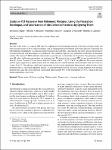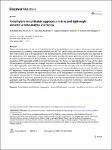Search
Author
- Abubakar, Sani Aliyu (1)
- Dimitrios N., Bikiaris (1)
- Nikolaos F., Nikolaidis (1)
- Nnamchi, Stephen Ndubuisi (1)
- next >
Subject
Date issued
- 2023 (2)
Has File(s)
- true (2)
Search Results
The aim of this study is to separate PET flakes by applying floatation technique, initially from binary polymer blends and later from the mixture of five common polymers such as polypropylene, polyethylene, poly(vinyl chloride), polstyrene and poly(ethylene terephthalate). A connection line between polymer and fiber is presumed in this study, because the dyeing of recovered polyester with three disperse dyes followed. The separation of plastics was performed in a Plexiglas air floatation column. The Lutensol® TO 8 surfactant of non-ionic origin was used to selectively wet the plastics. The parameters studied were pH values, surfactant concentration and treatment time. The dyeing of the recovered PET was performed with Serilene Blue RL, Serisol Crimson ECF and Serisol Yellow ECF dyes... |
Polyethylene terephthalate aggregates in structural lightweight concrete: a meta-analysis and review There is growing interest in the use of recycled materials in the building sector as a way to reduce waste and improve environmental sustainability. Polyethylene terephthalate (PET) is a thermoplastic polymer that has attracted the attention of researchers due to its application in the building industry. In the recent past, many studies have reported on the application of PET aggregates in structural lightweight concrete. This paper presents a review of the findings of 20 studies conducted between 2010 and 2022 randomly. The preliminary findings highlighted include the method of production of PET aggregates and their physical/thermal properties. The review extended further to focus on the extent of incorporation, physical properties, strength properties, and durability of concrete w... |


